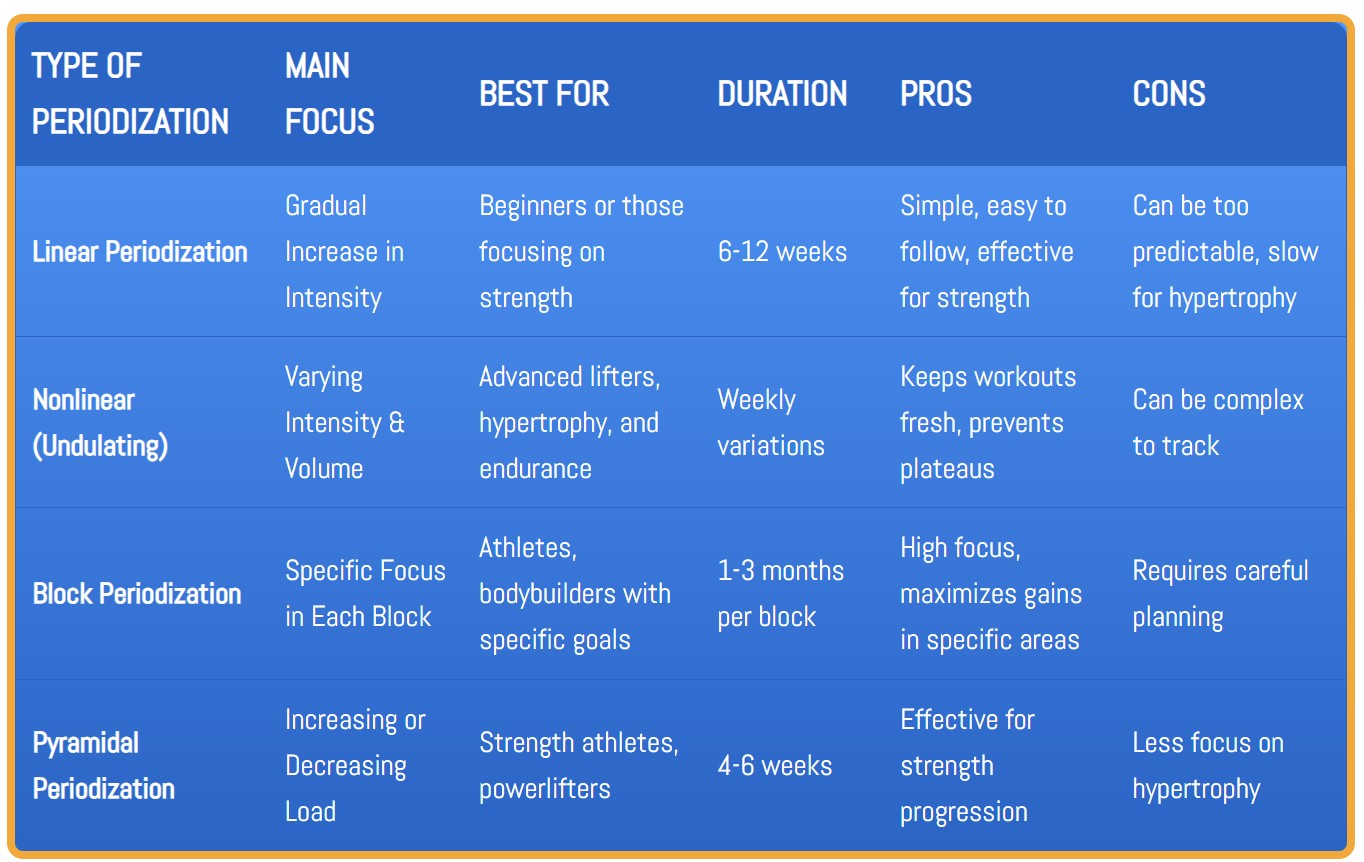Alright, let’s cut the crap. Periodization training is one of the most debated topics in the fitness world—and for good reason. You’ve probably heard all the arguments. Skeptics say it’s unnecessary. Others say it’s the way to increase strength, hypertrophy, and overall fitness. Well, guess what? The truth is somewhere in between.
Let’s dive in and break down the science, so you stop wasting your time on random, non-structured programs. If you’re serious about getting strong, toned, and seeing real muscle growth, this is for you.
What Is Periodization Training?
Periodization isn’t some fancy term to make you feel confused. It’s about strategically splitting your training into blocks (or cycles) to improve strength, endurance, and muscle definition over time.
| Key Aspect | Details |
|---|---|
| Macrocycle | A long-term plan, typically lasting 1 year. This includes multiple smaller cycles. |
| Mesocycle | Each macrocycle is divided into several blocks, usually lasting 1-3 months. |
| Microcycle | Shorter durations, lasting about 1-4 weeks, focusing on specific objectives. |
Why does it matter?
It’s all about systematically adjusting the load and intensity. This reduces burnout, promotes muscle growth, and helps you achieve the best results.
The Different Styles: Which One Fits You?

Skeptics love to question the “need” for periodization. Well, let’s break down the main types, and why each of them works for different goals.
- Linear Periodization
Most traditional approach. It starts light and increases weight and intensity as you progress through the cycles. It’s simple, but it works. - Nonlinear (Undulating) Periodization
This one’s for those who want variation. The intensity and volume change every week, keeping things fresh and challenging. It prevents plateaus. - Block Periodization
This is like the hyper-focused version. You train with specific intensity for different goals. One block might focus on hypertrophy, while another focuses on strength. It’s a game-changer for athletes or anyone with a specific performance goal.
Why Periodization Works: The Skeptics’ Key Takeaway
It all comes down to adaptation. The human body is brilliant at adjusting to stress, but it needs that stress to change. If you keep lifting the same weight, your muscles stop growing. Periodization changes the stress placed on your body to ensure continuous improvement.
Let’s talk about some real-world benefits:
- Optimal Hypertrophy & Strength Gains
By adjusting intensity, volume, and load across your blocks, you’re targeting different muscle fibers and giving them time to recover and grow stronger. - Avoid Overtraining
When you don’t program your training properly, you risk injury. Periodization helps you manage fatigue and ensures you’re always at the right intensity. - Psychological Edge
There’s nothing worse than getting stuck in a rut. Periodization keeps your workouts exciting and fresh, which boosts motivation. That psychological benefit alone will get you past any mental wall you hit.
Skeptical? Let’s Look at the Data
Some studies show that periodized programs consistently outperform non-periodized ones for building muscle. Here’s a quick breakdown:
| Training Type | Strength Gain | Muscle Growth | Fat Loss |
|---|---|---|---|
| Linear Periodization | Great for strength | Good for long-term | Slow but steady |
| Nonlinear Periodization | Keeps improving | Maximizes hypertrophy | Moderate |
| Block Periodization | Excellent for athletes | Very effective for muscle growth | Fast fat loss |
Is It Really For You?
I get it. You’re busy, and the idea of committing to long-term cycles seems like a hassle. But think about it this way: if you want consistent progress, you can’t just throw random exercises into the mix. You need structure.
Here’s how you can get started:
- Choose Your Goal: Hypertrophy? Strength? Endurance? Pick a focus for your first cycle.
- Start Simple: Use linear periodization. Focus on low volume and moderate intensity for the first few weeks.
- Commit: 4-6 weeks of focused training is all you need to start seeing results. If you don’t see any improvement, it’s time to adjust.
Skeptic to Believer: Real Talk
Look, I’m not saying you need to jump into periodization right away. But, you’ve been lifting non-stop, and still not seeing the type of muscle gains you want, right? That’s because you’re not challenging your body in the right way. You’re probably stuck in a loop of high volume or doing the same thing week after week.
Here’s the secret: switch it up. It’s as simple as changing your program structure to a system that actually works for you. Periodization is that system.
Q&A: The Deep-Dive for Skeptics
Q: What if I just want to build muscle, not focus on performance?
A: Periodization still works. You’ll just focus on hypertrophy. Block periodization will work best for maximizing muscle size while ensuring you don’t overtrain.
Q: How long does a cycle last?
A: That depends on your goals. A macrocycle usually lasts about 1 year, but you break it down into mesocycles (3-4 months each) and then microcycles (1-4 weeks) for fine-tuned progress.
Q: Can I use periodization if I’m training 3 days a week?
A: Absolutely. You can structure your training into low-intensity and high-intensity days. This gives you ample recovery and avoids burnout.
Q: What’s the best periodization program for beginners?
A: Linear periodization is your best bet. Start with lower volume, moderate intensity, and progress over time. Keep it simple, and add weight as you get stronger.
Q: I’m not into long cycles. Can I make adjustments mid-way?
A: Yes. One of the beauties of nonlinear periodization is that you can make adjustments based on your progress. The key is to stay flexible.
Final Thoughts: Make It Work

Periodization isn’t a gimmick—it’s a scientifically-backed strategy that works. Whether you’re focused on strength, muscle growth, or endurance, adjusting your cycles is the best way to see consistent improvement without hitting plateaus.
So, if you’ve been skeptical, give it a shot. Start with a simple plan, and watch your results skyrocket. The beauty of periodization is that it’s all about long-term progress, not instant fixes.
Ready to put in the work? Grab a program, stick to it, and watch your performance explode. Get your notebook, start now, and let’s go.
